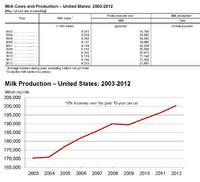 The National Agricultural Statistics Service of the U.S. Department of Agriculture announced last week that it will continue to provide an estimate of U.S. milk production each month through September 30. Just last month, the department said it would be forced to suspend the reports due to reduced funding caused by sequestration. During the weeks in between, IDFA’s legislative team worked with Capitol Hill staff and contacted the office of the Secretary of Agriculture to urge them to find a solution that would reinstate the reports.
The National Agricultural Statistics Service of the U.S. Department of Agriculture announced last week that it will continue to provide an estimate of U.S. milk production each month through September 30. Just last month, the department said it would be forced to suspend the reports due to reduced funding caused by sequestration. During the weeks in between, IDFA’s legislative team worked with Capitol Hill staff and contacted the office of the Secretary of Agriculture to urge them to find a solution that would reinstate the reports.NASS reports provide important information that is extensively used by both producers and processors in milk markets. The monthly milk production reports have helped provide transparency to the industry, and IDFA expressed concern when they were suspended.
The agency will use only various sources of administrative data to establish the monthly milk production estimates and will achieve budget savings by not conducting the two remaining quarterly producer surveys as is presently done.
Because NASS is not conducting milk producer surveys, the dairy cow and milk per cow statistics that were provided in previous reports will not be available. The agency said a scientifically based statistical survey will be necessary in the longer term to provide the additional estimates.
According to NASS, the decision to move forward with the limited milk production estimates is a reflection of its ongoing evaluation of agency programs and the fiscal situation, as well as its commitment to provide timely, accurate and useful data. NASS said it will continue to evaluate its programs and budget for FY 2014, which begins October 1.
The Balanced Budget and Emergency Deficit Control Act passed in 2011 mandated across-the-board spending cuts, commonly called budget sequestration, if Congress and the President failed to reach an agreement on significant deficit-reduction legislation. When the deadline for reaching an accord passed earlier this year, President Obama was forced to issue a sequestration order canceling $85 billion in federal government spending through September, the government’s fiscal year-end.





